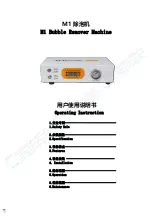
Operation Using a Programmable Logic Controller (PLC)
Network
Network
Network Communication
Communication
Communication --- Dynamic
Dynamic
Dynamic Command
Command
Command Structure
Structure
Structure (DCS)
(DCS)
(DCS)
Dynamic
Dynamic
Dynamic Command
Command
Command Description
Description
Description
The Dynamic Command Structure (DCS) is used to 1) access data that requires some form of argument(s) or 2)
consolidate data that requires multiple registers. The DCS uses a static set of network communication input and output
registers (see
Network Input Data Map (Write/Read), page 37
and
Network Output Data Map (Read Only), page 31
Use the following sequence for the DCS.
1.
Write the appropriate command arguments to INPUT REGISTERS 10 – 16. These commands may be written
sequentially or sent all at once.
2.
Once all arguments have been passed, write the command ID to INPUT REGISTER 17.
3.
The ProMix PD3K+ will respond to a valid command by writing a 2 (Acknowledge) to OUTPUT REGISTER 45.
4.
The ProMix PD3K+ will write appropriate return values to OUTPUT REGISTERS 37 – 44.
INPUT REGISTER 10
ProMix PD3K+ Inputs
(PLC Outputs)
ProMix PD3K+ Outputs
(PLC Inputs)
[arg_0]
INPUT REGISTER 10+ n
[arg_ n]
INPUT REGISTER 17
0000000000000000000000000000000000000000000000000000000000000000
0000000000000000000000000000000000000000000000000000000000000000
0000000000000000000000000000000000000000000000000000000000000000
0000000000000000000000000000000000000000000000000000000000000000
00000000000000000000000000000000000000000000000000000000000
00000000000000000000000000000000000000000000000000000000000
OUTPUT REGISTER 45
OUTPUT REGISTER 37
OUTPUT REGISTER 37+ n
[id]
ACK = 2
[rtn_0]
[rtn_n]
Can be written together
or sequentially .
Figure 15 Dynamic Command Structure Timing
3A6287E
47
















































